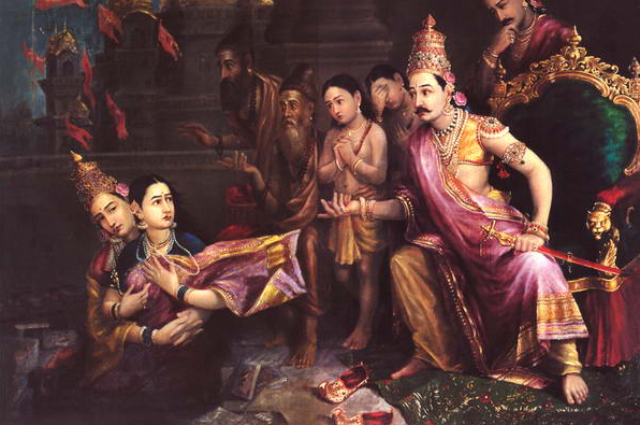Stories hold great importance in our lives. As we grew up listening to tales related to Diwali, we felt a sense of pride. Dressed in vibrant Indian attire and enjoying sweet treats, we celebrated our culture's lively festivities. From decorating our homes with lights to performing school plays about Diwali's legends, this festival has always been a beautiful reflection of our rich heritage. While Diwali symbolizes the victory of good over evil, its deeper layers are often overlooked. In this article, I explore the complexities of patriarchy and stereotypes in the Ramayana Epic and emphasize the need to embrace new perspectives.
The Ramayana's Diwali Symbolism and Its Effect on Our Culture.
While in exile, Sita, the wife of Lord Ram, is abducted by the demon king Ravana. Before he leaves, he creates a protective barrier around their hut and instructs her not to venture outside. However, Ravana deceives Sita and takes her to his kingdom. Rama courageously fights to rescue her and ultimately succeeds. This triumph is celebrated during Diwali, symbolizing the victory of light over darkness and good over evil. They return to Ayodhya, where Rama is crowned king, and the lighting of lamps during their return signifies the same themes of light triumphing over darkness, good overcoming evil, and civilization prevailing over nature. However, the deeper significance of this story is more intricate.
In Valmiki's original "Ramayana," Rama saves Sita but later decides to abandon her due to doubts about her fidelity stemming from her association with another man. To prove her purity, Sita undergoes a trial by fire, and they return to Ayodhya together. However, Rama becomes troubled by ongoing rumours about Sita's loyalty and ultimately exiles her to the forest while she is pregnant. Years later, they reunite, and Rama asks for her forgiveness in front of a crowd. Instead of returning with him, Sita opts to pray for her return to the earth, leading the ground to open up and accept her, adding an unexpected twist to the story.
The narrative primarily examines the theme of dharma, or the proper way to act, set against a backdrop of societal change from tribal multiculturalism to larger kingdoms in the Gangetic plain around 500 BC. This transformation highlights the need for established customs and laws to support evolving communities. Sita's choice to stay in the forest reflects the text's ambivalence towards the foundations of statehood and her resistance to toxic masculinity and rigid social norms that prioritize duty and honour over personal relationships.
The Indian Media and the Ramayana: A Patriarchal Reflection
This element of the narrative is frequently neglected in modern discussions. Just as we were given a simplified version as children, present-day media often simplifies and diminishes the complexity and depth of the original story. The most famous adaptation of the "Ramayana" today is the serialized version by producer-director-writer Ramanand Sagar, which aired on India's national television, Doordarshan, in the late 1980s. It rapidly became the most-watched television series worldwide, with reruns broadcast on 20 different channels in 17 countries across all continents and time zones.
After Sita's rescue, her pregnancy led to doubts about her purity, with people speculating that Ravana may have assaulted her, raising questions about her children's paternity. Despite knowing Sita was innocent, Lord Rama chose to send her to the forest to give birth and raise their children away from society. This raises troubling issues regarding responsibility and support in difficult times. Shouldn't Rama, as her husband, offer love and protection rather than abandonment? Sita deserves recognition beyond her physical purity, and Rama should defend her against such accusations. His behaviour does not exemplify the admirable qualities we would seek in a partner. Growing up in the Indian community, we often encountered narratives that portrayed women as sorrowful figures, while men demonstrated strength through actions like archery.
This portrayal not only reinforced gender stereotypes but also diminished Sita’s rightful anger at her abandonment in the forest. In Sagar's adaptation of the epic, Sita is shown as voluntarily proposing her banishment to preserve Rama’s honour. This version has had a significant impact on women in India, where literacy rates were low at 39.42%, and among the diaspora, where Hindu epics are rarely studied. It perpetuated the image of the ideal Indian woman as passive, self-sacrificing, and subdued. While the traditional view of Diwali celebrates Lord Ram's victory over evil, it often overlooks the complexities within the narrative.
The Ramayana, while symbolizing the triumph of truth, also highlights issues of patriarchy, the oppression of women, and the harmful idealization of female chastity that persists in Indian society. Many families continue to uphold traditional Diwali customs, where men engage in political discussions while women handle cooking, cleaning, and childcare. As we move forward, it is vital to develop a more nuanced understanding of the Ramayana, recognizing Sita as a figure who challenges gender norms and confronts toxic patriarchy, which can encourage changes in household dynamics during Diwali.
Conclusion
What additional aspects can we honour during Diwali? When viewed from a different perspective, this festival highlights themes of togetherness, family, unity, and love. Although Diwali represents the triumph of light over darkness, its significance extends beyond the tale of Lord Rama's conquest of Ravana; it also underscores vital values such as perseverance and compassion within our communities. Let’s cultivate the light within ourselves by promoting true equity and celebrating the triumph of humanity, love, and justice over negativity, hatred, and patriarchy.

